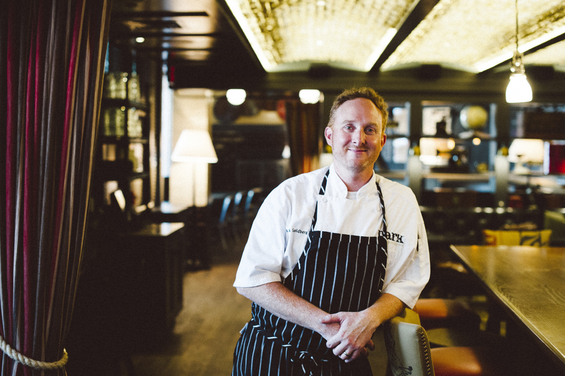
I know Australians have a meat pie, and my sister’s father-in-law, who is French Canadian, has a meat pie. But you had a special meat pie for Chanukah and will have a special meat pie for Christmas? What makes these pies distinct for these winter holidays?
At Park, we have a daily meat pie special. The filling changes every two days or so, and we are always looking for new ways to present classic items within the crust (like meatball marinara, chicken marsala, steak & cheese, barbecue brisket, short rib & mushroom, etc.). The pies are individually sized, completely enclosed rectangular pies. They offer a substantial meal and the leftovers eat almost as well the next day.
For Chanukah we tried to think of how to bring the traditional dinner into the pie – brisket, potato latkes, applesauce. What we came up with was a brisket, caramelized apple and roasted potato pie to recreate those classic flavors in a new format. Likewise, for the Christmas season, we will feature a roasted goose and fig pie as a way to offer a new presentation of the timeless holiday feast.
Your menu boasts lots of comfort food. When I think comfort food, I think brisket and kugels. When others think comfort food, it might mean mac and cheese and spaghetti and meatballs. What does comfort food mean to you?
Comfort food to me is any food that conjures up memories, creates a warming feeling and satisfies hunger both in the stomach and the soul. Dining is a very social activity, and it’s those memories of good times, great company and good food that summon the notion of comfort and security.
Growing up, we always had big family dinners around the holidays with brisket, matzoh ball soup, knishes, tzimmes, kugel. Those are the comfort foods from my “Jewish” memories.
Comfort food at home, with my family, tends toward stews in the cold months and grilling anything and everything during nicer weather. Mac n’ cheese is always a big hit in our house as well (and we’re not talking boxes of Kraft).
Tell me a little bit about your work with The Food Project.
I was introduced to the amazing people at The Food Project almost four years ago. When I was opening the Ames Hotel, The Food Project was gracious enough to allow me to use their kitchen as my test kitchen. The staff was also very grateful to sample all my endeavors.
I really fell in love with what TFP does – teaching youth, both inner city and suburban, about sustainable agriculture, maintaining a healthy diet and taking care of the land. But more important than that, they instill confidence in the youth, teach them diversity, create healthy lifetime eating habits, educate them on social issues and, for many, give them a respite from the harsh reality they live in.
I have been lucky to participate in three of the organization’s lunch series programs over the last few years. These offer an opportunity to work with about a dozen TFP youth to create a meal for 50-70 TPF participants, volunteers and community figureheads using produce they grew and harvested. Each year, I bring one of my daughters with me to help. They fight over whose turn it is next to go, they love it as much as I do. My eldest daughter (now 12) can’t wait to apply to the summer program when she turns 14.
From a restaurant aspect, TFP started growing produce out of a greenhouse in Dorchester that we purchase tomatoes from, and they are now diversifying into greens as well. The 30-plus acres of land that TFP grows on (an amazing few acres right in Dorchester and 30 acres in Lincoln) supply the farmers’ markets that sell the produce back to the community at amazingly affordable prices. (The markets are also run by the youth.)
What food trend will you miss the least?
I am so excited that the new “trend” is actually moving back to basics. Retro is the new trendy. Long, slow processes (confit, braising, curing) are the new trend.
I think I will miss the molecular gastronomy trend the least. It is amazing what people can do to food using unconventional processes, but I prefer the tried-and-true methods. I think we can leave the chemicals in the labs of Harvard and MIT.


